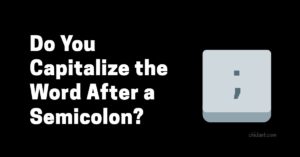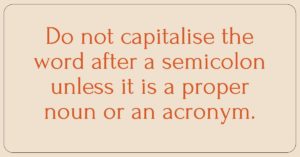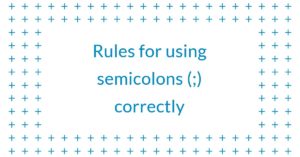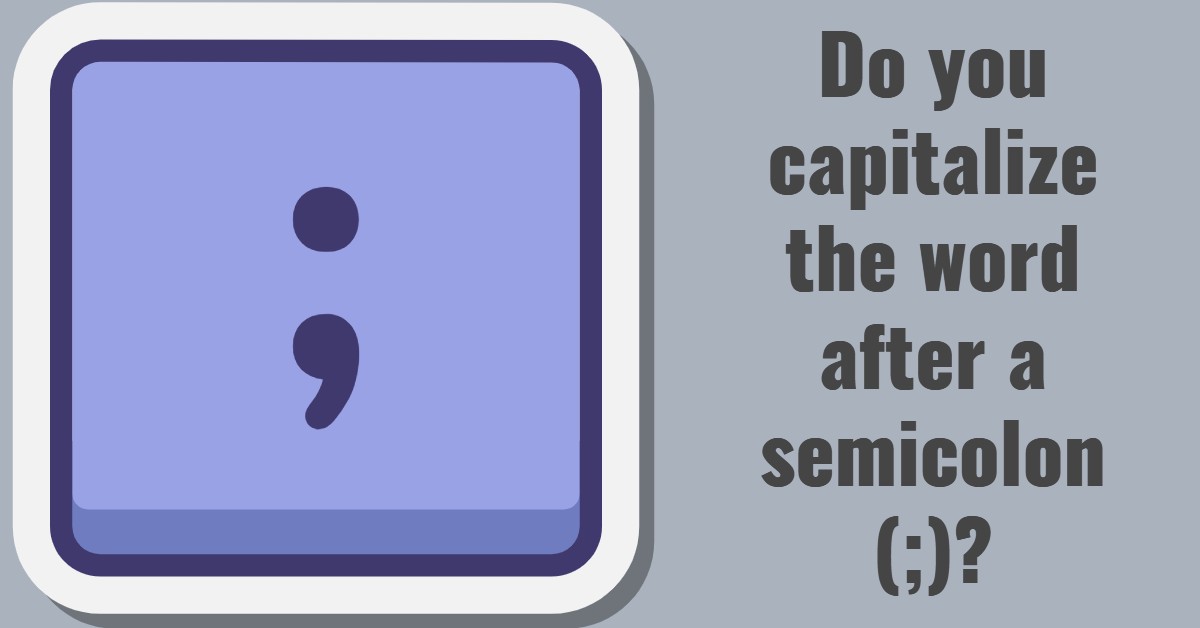Let’s learn correct punctuation and capitalization. I have an interesting question to ask and provide the answer to: do you capitalize the word after a semicolon (;)?

In explaining the answer to the question, I will show you what a semicolon is, the correct way to use it in a sentence and generally in writing and when to use it. We will also learn about using the colon (:).
I’m excited already. Let’s begin our study in detail.
What is a semicolon?
The semicolon is a perplexing grammatical oddity that many writers misuse or avoid altogether.
On a light note, semicolons (;) are as basic as a period stacked on top of a comma.
In simple terms, a semicolon (;) is a punctuation mark indicating a pause, typically between two main clauses, that is more pronounced than that shown by a comma.
Semicolons cannot be used in place of commas or periods. Instead, they’re somewhere in the middle: more powerful than a comma but not as divisive as a period.
Do you capitalize the word after a semicolon?
Here’s the big question. What’s the correct way to use a semicolon?

The correct way to use a semicolon
The semicolon is most commonly used to join two independent clauses without the use of a conjunction such as “and.”
After a semicolon, do you use a capital letter? In general, the answer is no. Only if the word is a proper noun or an acronym should a semicolon be followed by a capital letter.
For Example, We could go to the State e-library to do some research; Fridays are relatively quiet there.
When to use a semicolon

For correct use of the semicolon, it is necessary to identify the independent and dependent clauses in the sentence.
A semicolon connects two related ideas by narrowing the gap between two separate sentences’ ideas or by replacing the conjunction between two related ideas.
That also applies to showing contrast: just because two ideas are opposed or contradictory doesn’t mean they aren’t related closely enough to warrant a semicolon.
The following examples will help:
Example 1
When joining two independent clauses with a semicolon, do not capitalize the first word of the second independent clause unless it is a proper noun, as in the example below:
Example: The night is dark; the stars are shining.
Example 2
You should not capitalize the first word in a list after a semicolon unless the word is a proper noun. Take careful note of the example below:
Example: During Ben’s holiday, he visited many UK cities, including Manchester, home to Manchester United Football Club; London, the capital city; and Birmingham, the country’s commercial center.
Example 3
In a multi-author citation, capitalize an author’s name after a semicolon.
For example: (Ajdan and Scott, 2010; Jack and Okpon, 2009).
How to identify independent and dependent clauses
Independent and dependent clauses combine to form descriptive sentences.
Example: The sunset filled the sky with a deep red flame, setting the clouds ablaze.
Independent Clauses
An independent clause, also known as restrictive clause, contains a subject and a verb and can stand alone as a sentence. For example, “the sunset filled the sky with a deep red flame.”
Independent clauses provide the most important information in a sentence.
Dependent clause
Dependent clauses, also known as nonrestrictive clauses, can have a subject and a verb, but they are incomplete sentences that require an independent clause to make sense, such as “setting the clouds ablaze.”
A dependent clause provides non-essential information that, if removed, would not affect the meaning of the remaining sentence.
Rules for using semicolons correctly
The guidelines for correctly using semicolons are as follows:

1. Use semicolons to connect related independent clauses
A semicolon can be used to connect two independent clauses that are closely related.
To put it another way, the words preceding the semicolon should form a complete sentence, the words following the semicolon should form a complete sentence, and the two sentences should have a close, logical connection.
Examples:
- There was a strong wind at the beach; we managed to have a good time anyway.
- I was very happy; I had pizza and ice cream.
- Some authors prefer to use a word processor; others write using pen and paper.
- I really wanted potato soup; the cafe only served clam chowder.
- Today is Thursday; the test is on Friday.
- She had just bought two gorgeous dresses; she needed to get matching shoes.
It’s worth noting that the letter after the semicolon is not capitalized.
Both of the preceding examples are made up of two complete, grammatically correct sentences that have been glued together.
A comma cannot be used in place of a semicolon. Using a comma instead of a semicolon in the preceding sentences would result in a comma splice. You don’t want that.
2. When using a semicolon between two independent clauses, remove the conjunction.
A semicolon isn’t the only thing that can connect two separate clauses—conjunctions (and, but, or, yet, so, for) can also accomplish this. However, you should not use a semicolon and conjunction together.
That is, when you use a semicolon, you are replacing a conjunction; you do not need both.
Here’s a hint: if you used a comma and a “and” to connect two related ideas, consider using a period (the top part of the semicolon) instead of “and.”
Example:
- A group of us went to the movie, and we agreed it was enjoyable.
- A group of us went to the movie; we agreed it was enjoyable.
Note:
- To avoid a comma splice, you need a comma plus something. That something could be the correct conjunction or the period that converts a comma to a semicolon.
- If semicolons can connect independent clauses that would otherwise be separated by a period or conjunction, it follows that they can also demonstrate contrast. This is a variation on the same rule; the conjunction in question is “but” rather than “and.”
3. In a serial list, use semicolons.
If the items in a list are long or contain internal punctuation, semicolons can be used to separate them. The semicolon aids readers in keeping track of the divisions between the items in these cases.
Examples:
- I’m looking for weather data for the following cities: London, England; London, Ontario; Paris, France; Paris, Ontario; Perth, Scotland; Perth, Ontario.
- My plan included taking him out to a nice—but not necessarily expensive—dinner; going to the park to look at the stars, which are spectacular this time of year; and serenading him with my accordion.
4. When using conjunctive adverbs, use semicolons.
A semicolon should be used when a conjunctive adverb connects two independent clauses.
Furthermore, nevertheless, however, otherwise, therefore, then, finally, likewise, and consequently are some common conjunctive adverbs.
Examples:
- Amy practiced the piano; meanwhile, her brother went out with his friends.
- Simon won’t be attending the show; therefore, he has an extra ticket for anyone that can use it.
- The workers are demanding better pay; additionally, they want longer breaks.
- You must do your homework; otherwise, you might get a bad grade.
- I needed to go for a walk and get some fresh air; also, I needed to buy milk.
- Reports of the damage caused by the hurricane were greatly exaggerated; indeed, the storm was not a “hurricane” at all.
- The students had been advised against walking alone at night; however, Cathy decided walking wasn’t dangerous if it was early in the evening.
- I’m not all that fond of the colors of tiger lilies; moreover, they don’t smell very good.
Note:
- Because these words can appear in other parts of a sentence, the semicolon rule only applies if it aids the conjunctive adverb in joining two independent clauses.
- The conjunction rule is analogous to this conjunctive adverb rule.
- Check that the two ideas are independent clauses that can stand on their own as sentences in both cases. If this is the case, you’re good to go in terms of the semicolon.
Do you capitalize the word after a colon (:)?
The following rules apply to capitalization of the first word after a colon:
- When connecting two clauses with a colon, capitalize the first word of the clause after the colon if it is a complete sentence. For example, On January 28, 2016, flooding caused road closures: Both Highway 1A and Cowichan Bay Road were closed due to washouts.
- After a colon, do not capitalize the first word of a dependent clause. For example, I have three tasks to complete before my document is finished: check my references, proofread for typos, and read the document aloud to ensure the text makes sense.
- Consider whether the first word of a bulleted or numbered item is an independent or dependent clause when deciding whether to capitalize it. Capitalize the first word if the item is an independent clause.
- If the item is a dependent clause, you should not capitalize the first word.
- In a reference, capitalize the first word of the subtitle. As an example: This is the title: This is the subtitle.
Check out Source and other reference materials here.
To summarize, let me ask again; do you capitalize the word after a semicolon?
The answer to whether or not to capitalize the first word after a semicolon or colon is most likely “it depends.”
Follow the rules outlined in this article for the proper grammatical use of semicolons and colons.
Recommended:
Examples of Private High School Application Essay 2023 | How to Write an Excellent Application Essay
National Junior Honor Society Application Guide and Essay Examples

